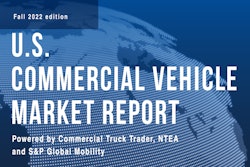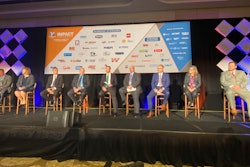
A new report Thursday by Commercial Motor Vehicle Consulting (CMVC) addresses the recession potential for the United States' economy in the months and year ahead.
According to CMVC, risks of a recession for the U.S. appear in the medium term as there are few signs the economy is entering a recession in the near term as employment gains remain solid, consumer spending increasing at moderate growth rates, backlog of unfilled orders high, industrial production trending upward and business profits high.
Looking at current conditions, CMVC says the growth rate of the U.S. economy was expected to slow in 2022, since the economy could not sustain 2021’s growth rate of 5.9 percent due to labor and material shortages.
[RELATED: Truck tonnage rose by 6.8 percent in 2021]
The risk of a recession is the result of the Federal Reserve Board’s delicate balancing act of tightening monetary policy to the point of dampening inflationary pressures without pushing the economy into a recession. CMVC says the lag between shifts in monetary policy and their impact on the real activity, consumer spending, business investment spending and trade presents challenges to the Federal Reserve, since there is a variability in the lag between raising rates and results. Interest rates are increasing from ultra-low levels, so the lag period may be longer than anticipated and COVID-19 effects on the economy also adds variability to the lag period.
The lag period is a known unknown, CMVC states, but sooner or later higher interest rates will be a drag on the economy, dampening inflationary pressures. The interest-sensitive housing sector has begun to feel the effects of higher interest rates, as housing starts and home prices are decreasing. CMVC states the arguments within the Federal Reserve Board are should they let current interest rate hikes take effect before making further adjustments in monetary policy, but the risk is inflation remains high for an extended period of time. The other side of the coin is the existence of lags cannot be an argument for inaction and rates should continue to increase until there are signs of decreasing inflation. The Consumer and Producer Price Indexes imply inflationary pressures remain high, CMVC says.
Additionally, the Federal Reserve faces enormous challenges in getting monetary policy right, CMVC states, and the balance of not excessive tightening pushing the economy into a recession, but tightening to the point of dampening inflationary pressures. Monetary policy is not a science due to the unpredictability of lags, so the upward trend in interest rates due to the tightening of monetary policy increases the risk of a recession in the medium term, the company says.
CMVC believes the risk of the U.S. economy entering a recession are from the second quarter of 2023 through 2024 due to unpredictability in the lag between increasing interest rates and the effects on the real economy — consumer spending, business investment spending and trade.
In conclusion, CMVC states the freight environment remains solid, which will support pent-up truck demand, normal truck replacement demand, fleet capacity expansion to catch up with past freight growth and fleet capacity expansion to meet future freight growth. A recession, however, would substantially change fleets’ truck investment spending plans as lower freight volumes depress fleet capacity utilization, causing fleets to reduce capacity, truck sales below replacement demand volumes and lower fleet capacity utilization would swing the pricing pendulum towards shippers, thereby squeezing for-hire carriers’ profit margins.
[RELATED: ACT Research slightly lowers market forecasts]
The risks of a recession are evaluated due to the Federal Reserve Board’s delicate balancing act of slowing economic growth to the point of dampening inflationary pressures without pushing the economy into a recession, CMVC says.











